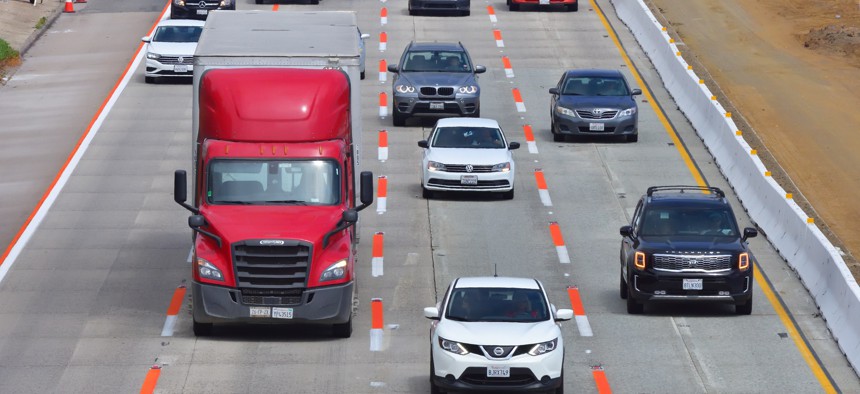States Experiment With Orange Highway Striping in Work Zones

California traffic engineers are experimenting with orange road paint to see if it improves safety in construction zones. Caltrans
It’s among the latest attempts to cut down on crashes in construction areas.
Traffic engineers in southern California are trying to figure out whether orange striping in work zones can help improve safety, an idea that their counterparts around the country have tried to perfect for more than a decade.
The California engineers are using the orange pavement markings during construction to add carpool lanes on a four-mile segment of Interstate 5 north of San Diego.
The state transportation department is using the extra color to help highlight the white and yellow lane markings while the highway is expanded. On one side of the highway, the orange lines are on either side of white dashes, framing them like an Oreo cookie. On the other side, Caltrans is trying a design where the color of the dashes is split into two sections lengthwise, with one half white and the other orange.
The state’s approach is a bit different from previous experiments with orange striping in Wisconsin, Texas and Kentucky, where the highway departments used orange paint instead of traditional white or yellow.
“I thought the easiest thing would be to leave that normal striping alone and use orange as a contrast color,” said Brian Hadley, a Caltrans engineer overseeing the project.
California, like many other states, often uses black paint to make white stripes stand out, particularly on concrete pavement or on east-west roads where sun glare can make white stripes hard to see.
States have long tried to improve safety in work zones. According to the National Safety Council, 857 people were killed and 44,240 people were injured in work zone crashes in 2020.
Highway crews regularly deploy plenty of precautionary measures to warn motorists about construction on the road, including barriers, barrels and flashing signs.
But Hadley says motorists are especially attentive to signals on the roadway itself. That’s one reason why highway shields painted on the pavement of interchanges—so drivers know which lane will take them to the highway they want to follow—are so popular, he said.
“For myself personally, I feel like when I’m driving, I’m looking more at the road than at the signs,” he said.
Engineers have also found that improved striping at the edge of roads reduces the number of incidents where people drive off the road. And California has shown that reflectors with red backs on road surfaces help reduce the number of people who drive the wrong way down a road, too, he noted.
Previous experiments with orange striping have had mixed results.
Wisconsin, for example, used orange paint instead of white paint in certain segments during a massive rebuild of the Zoo Interchange in Milwaukee.
The new color didn’t cut down on crashes, but it proved popular with drivers. Eighty percent of drivers who responded to a survey said the orange color increased their awareness that they were in a work zone, while 83% said the orange was easier to see than white striping.
The Wisconsin engineers also made recommendations on the color and type of paint that worked most effectively.
Kentucky started using orange striping for Interstate 75 in 2019. The state also planned to paint 8-foot-tall letters on the pavement to show a 55-mph speed limit. An evaluation of the project, though, found that speeds remained the same in segments with orange striping and white striping.
A toll authority in North Texas has also experimented with orange striping. Initial results showed that 61% of motorists who responded to a survey said the orange raised their awareness that they were in a work zone, while 88% of respondents said they’d like to see the color in other Texas construction zones.
Transportation departments in Canada and New Zealand have also experimented with using orange paint for construction zones.
In California, engineers will track the effectiveness of their color scheme using video monitors to evaluate vehicle movements, along with devices to track the brightness and reflectivity of the paint over time.
Hadley hopes the improvements will be significant enough that the Federal Highway Administration and state officials will allow for orange to be used as a contrast color on future construction projects. That would require an interim approval for an exception from the federal Manual on Uniform Traffic Control Devices and from its California equivalent.
But Hadley notes that those exceptions can be granted after a convincing experiment, such as when California gained approval to add red-colored bus lanes on freeway entrances.
The department first got approval for the plan in 2020. It expects testing to continue on the new striping for about a year while construction continues, Hadley said.
Daniel C. Vock is a senior reporter for Route Fifty based in Washington, D.C.
NEXT STORY: Choosing the right mobile tech to enhance first responder workflows






